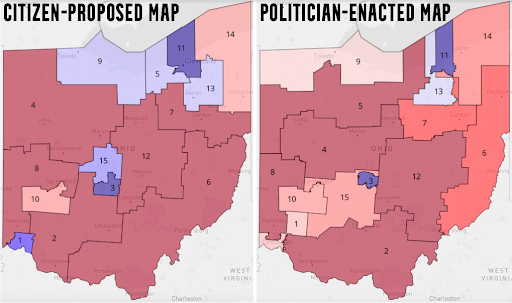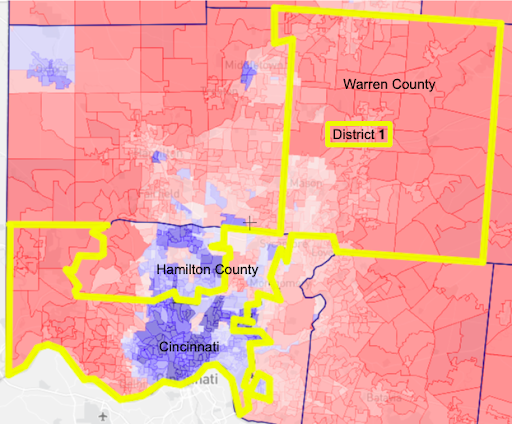By Kyle Herman
Even where reforms were passed to require fair, nonpartisan districts—like with a constitutional referendum approved with 75% of the vote in my home state Ohio—politicians have ignored the will of voters by manipulating maps to give themselves partisan advantage. Without competitive elections to hold them accountable, politicians are effectively using gerrymandering to rig elections by choosing their own voters instead of allowing voters any real choice. As newly gerrymandered districts are challenged in courts, the next step in the fight for fair and competitive elections is ranked choice voting.
As you probably know by now, ranked choice voting can make elections more competitive by empowering more candidates from across the spectrum to run without fear of splitting the vote. RCV’s instant runoff process makes it more likely that the winner will accurately represent a majority of voters because they need more than 50% of votes—unlike our current plurality-wins system, in which a candidate can win with a fraction of the vote. With more than two candidates or parties able to compete in each race, trying to gerrymander districts in the future would be harder than the simple way they’re drawn now based on the two-party split.

The map on the left won Fair Districts’ competition and scores higher on all metrics on Dave’s Redistricting (proportionality, competitiveness, minority representation, compactness, and splitting) than the actual map enacted by politicians on the right.
The way Ohio’s redistricting reforms were subverted shows why RCV is necessary to blunt the harms of gerrymandering, including polarization and lack of competition. Ohioans amended the state constitution in 2018 to explicitly require that “every congressional district will be compact” and to outlaw any plan that “unduly favors or disfavors a political party.” Civil society groups like the Ohio Citizens Redistricting Commission and Fair Districts Ohio demonstrated how a compact and fair map was possible. However, partisan politicians ignored the state constitution and passed a map with districts that are anything but compact or fair—one party is favored in at least 80% of districts even when that party barely wins 50% of votes. The Princeton Gerrymandering Project graded the Ohio map as an “F,” and Dave’s Redistricting listed the metric for “proportionality” (partisan fairness) as “very bad.”
The skewed partisan advantage was achieved by breaking up metro areas so that urban and suburban communities are split into pieces and attached to far-flung counties that can drown their votes. For example, rather than keep Cincinnati and its suburbs intact in Hamilton County, the northern suburbs were carved into District 8, the eastern suburbs were broken into District 2, and the city was attached by a thread to Warren County, where enough white rural voters give Republicans an advantage in District 1. Although nearly 50% of Cincinnati’s population is Black, the city and its suburbs were split three ways to effectively deny them representation. Other metro areas like Akron were similarly broken up. While the cities of Columbus and Cleveland each have their own districts, the map fractures their suburbs to dilute their voting power—like how districts bordering Cleveland’s Cuyahoga County stretch the entirety of the state from Indiana (District 5) to Pennsylvania (District 14) and halfway to Columbus (District 7).

District 1 gerrymanders the Cincinnati metro area to create a polarized district with skewed partisan outcomes.
While the map’s proponents claim that they’re creating “competitive” districts by attaching diverse, urban communities to rural counties, they’re actually trying to give themselves partisan advantage and worsening polarization by forcing geographically and demographically dissimilar groups into the same district, causing more voters to feel neglected by politicians who don’t represent their values. Our current plurality-wins system increases the chances that extreme outcomes will be pre-determined by small, unrepresentative groups—like when a congressional primary in a noncompetitive district was won with only 37% in Ohio earlier this year. RCV can help decrease polarization and achieve representation closer to the average voter because it changes the incentive structure so that winners have to build broader, more inclusive coalitions to win majority support in a general election, rather than simply win a primary by inciting partisan extremists. This opens the door for new parties and independent-minded candidates to run campaigns focused on finding common ground instead of stoking divides.
An even more effective way to stop gerrymandering would be proportional RCV, written about here. However, switching to multi-member districts in order to achieve proportional representation would require an act of Congress. An advantage of RCV is that it can be passed state-by-state like it was by ballot initiative in Maine and Alaska. Getting voters used to RCV for single-member races or local multi-member races—such as at-large city council—could increase national support for proportional RCV.
With redistricting reforms failing to lead to fairer districts so far, and with uncertainty about whether partisan justices will uphold or ignore the new redistricting laws, activists and editorial boards have been scrambling to find new ways to counteract the harms of gerrymandering. The next logical step is to pass RCV so that all elections can be more fair and competitive, and to enable coalitions to form among more parties and candidates to hold politicians accountable for corruption or for attempts to rig elections with gerrymandering in the future. Imagine, for example, if candidates for Secretary of State were incentivized to appeal to the majority of voters who support nonpartisan election administration instead of caving to extremists in their own party to ward off a primary challenge.
Groups like Rank the Vote Ohio are already working to bring RCV to Ohio and other states, and they need help from everyone concerned about democracy in order to achieve more accurate representation.
###
Kyle Herman is a co-founder and co-executive director of Rank the Vote Ohio. He has experience working for elected officials at the local and national levels and is currently working for an international nonprofit on democracy assistance programs in other countries. Kyle is a graduate of Ohio Wesleyan University and the Harvard Kennedy School of Government.
The views and opinions expressed in this article are those of the authors and do not necessarily reflect the official policy or position of Rank the Vote, its members, supporters, funders, or affiliates.






